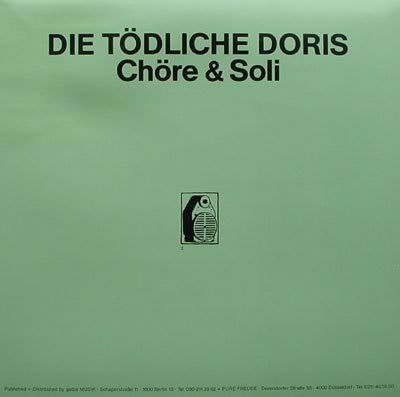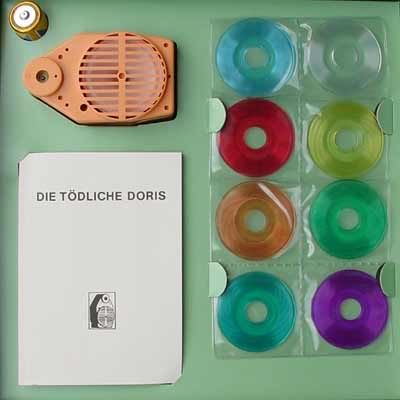Mention of Die Tödliche Doris in the previous piece about Nan Goldin has made me want to share the joy and excitement I felt when I finally became the proud possessor of their "Chöre & Soli" box set a few weeks ago when it made one of its very rare appearances on Ebay. I don't mind saying, either, that I payed rather a lot of money for it as it's an item I've coveted since the day I read about its imminent release in the 8th October 1983 issue of the NME all those years ago.
This was actually my first brush with the band/art collective who had, by then, been in operation for about three years and had released several cassettes, as well as an album and 12" for journalist Alfred Hilsberg's Hamburg-based Zick Zack label, an endeavour which cannot be praised enough for also bringing us some of the earliest releases by the likes of Einstürzende Neubauten, Andreas Dorau, Die Krupps, Palais Schaumburg and X-Mal Deutschland during the opening years of the 1980s, as well as other fantastic records by less internationally reaching artists such as Saal 2, Wirtschaftswunder, Abwärts, Sprung Aus Den Wolken and Der Radierer.



As well as their musical output, The Deadly Doris had also been busy making films, including the infamous "Das Lebens Des Sid Vicious"(1981) in which sometime collaborator Dagmar Dimitroff's two and a half year old son plays the eponymous subject whose life is distilled into just ten minutes of quite startling footage. A couple of stills from the film, which sees him toddling around in a swastika t-shirt, playing with a rubber knife in a squalid apartment, fighting with and murdering a four year old Nancy Spungen and overdosing on heroin, were included in the article and these, along with talk of the aforementioned box set and a growing fascination for anything to do with the increasingly documented Berlin scene which had brought us Neubauten, Malaria and others, had me hooked. As a twelve year old with quite a limited income, though, the delights of coming into contact with any actual Die Tödliche Doris product were several years away.
A selection of their films, by the way, was on display at the Hamburger Bahnhof in Berlin a few years ago and made for extremely interesting viewing. They also made it over to Newcastle around the same time for a showing at the Star and Shadow Cinema when a tiny exhibition of the band's work was staged at the record shop alt.vinyl in the city. Quite a few of these films can be found on the internet, including the one mentioned above, although not the memorable "John Heys Sings"(1984) which, in the words of Chris Bohn (Wire Magazine, July 2006) features "an American who looks like an animated figure from an Otto Dix painting (and who) croons a theatre song in his pension, accompanied by his landlord, in a style that evokes Isherwood and Weimar". Here's a little selection of what is out there, though:
A selection of their films, by the way, was on display at the Hamburger Bahnhof in Berlin a few years ago and made for extremely interesting viewing. They also made it over to Newcastle around the same time for a showing at the Star and Shadow Cinema when a tiny exhibition of the band's work was staged at the record shop alt.vinyl in the city. Quite a few of these films can be found on the internet, including the one mentioned above, although not the memorable "John Heys Sings"(1984) which, in the words of Chris Bohn (Wire Magazine, July 2006) features "an American who looks like an animated figure from an Otto Dix painting (and who) croons a theatre song in his pension, accompanied by his landlord, in a style that evokes Isherwood and Weimar". Here's a little selection of what is out there, though:
After the punk inspired, industrial leanings of their outings on Zick Zack, "Chöre & Soli" is much more in the dadaesque spirit of the band which is, perhaps, best exemplified by their performance at Die Grosse Untergangsshow: Festival Genialer Dilletanten, held in a circus tent near Berlin's Potsdamer Platz on 4th September 1981. On this occasion, like the rest of the band, frontman Wolfgang Müller was painted and covered in fur, with the addition of feathers attached to his fingers in order to hamper his attempts at playing the violin. A similar example of these tendencies came when they were asked to perform in front of The Wall for a special Berlin edition of German music programme "Rockpalast" in 1984. Free to choose their spot, Die Tödliche Doris selected a section obscured by a mound of sand and then performed two pieces based on the theme of natural catastrophes. In the first of these, "Naturkatastrophenballet", the three members march and sway on the spot in muddy puddles, performing a kind of dance to accompany Müller's dispassionate account of various natural catastrophes. The "musical element" is provided by Käthe Kruse whose movements rattle the teacups and the like which dangle on threads from her arms, as well as the sheet of metal attached to her back. In the second section, "Naturkatastrophenkonzert", Kruse spits fire onto a microphone positioned in front of the mound and, as it burns into uselessness, first Müller and then Nicholas Utermöhlen appear over the obstruction, approach and perform little ditties, Müller on the violin and the latter on an accordian, the keys of which have been covered with drawing pins. As the microphone eventually gives up the ghost, the reassembled group, now in a line, perform a valedictory dance. Marcel Duchamp, I'm sure, would have approved.
"Chöre & Soli", instead of being a conventional 12" record, came as a greeny blue box, limited to 1000 copies and released jointly by Gelbe Musik (Berlin) and Pure Freude (Düsseldorf), and contained a set of eight two inch coloured discs, a battery operated player, the like of which was usually found embedded inside talking dolls, and a booklet containing lyrics, photographs and other text. Across sixteen tracks, one on each side of the discs and each lasting upto twenty seconds, the band and occasional fourth member, Berlin model and actress Tabea Blumenschein, perform a series of squeaky nursery rhyme like accapela solos and choruses totally suited to the equipment on which they are presented and played, all sung in German except for one performed in English. In this latter track, the lyrics read: "You see, we come as friends. / Don't worry. / We know how to take care of ourselves. / So don't get heroic and try to follow me. / (You see we come as friends, you see we come as friends.)" Other examples of translated lyrics read: "The air is full of light / And I can see you well / My heart, it doesn't hear your laughter / It pumps itself so full of blood" or "(...up in the air) / We are two widows / And we live in the same house / And both lost our husbands on 20th May 1975 / (high up in the light) / We still cry" or "The musician passes you the hand / (white spots on the fingernails and the number seven on the heart line) / The Siamese cat eats grass... / See you in the wedding gear not over". Maybe I got the last one a bit wrong. I'm not great at German. I'm sure you get the picture, though. It might sound a bit silly but I love it and it certainly fulfilled their intention as explained by Müller in an interview: "We want to become the most independent band of all independent bands–even independent from a usual record player. But also independent from music-reviews and critics, which want to put you in her sound- and identity-system."
As an interesting coda, Die Tödliche Doris performed selections from "Chöre & Soli" live at the Delphi Palast in Berlin on New Year's Eve 1983/4 as part of an exhibition called "The Inclination Towards The Total Work Of Art" by Harold Szeemann. This was then released as a cassette which, like a lot of their output, has since been reissued in a very limited format by the Vinyl-on-Demand label. Here is a film featuring five pieces.
Although Die Tödliche Doris ceased to exist in 1987, their legend lives on and they still remain a source of fascination to me and I cherish everything related to them that I own. This above is just the tip of the iceberg, too.



No comments:
Post a Comment